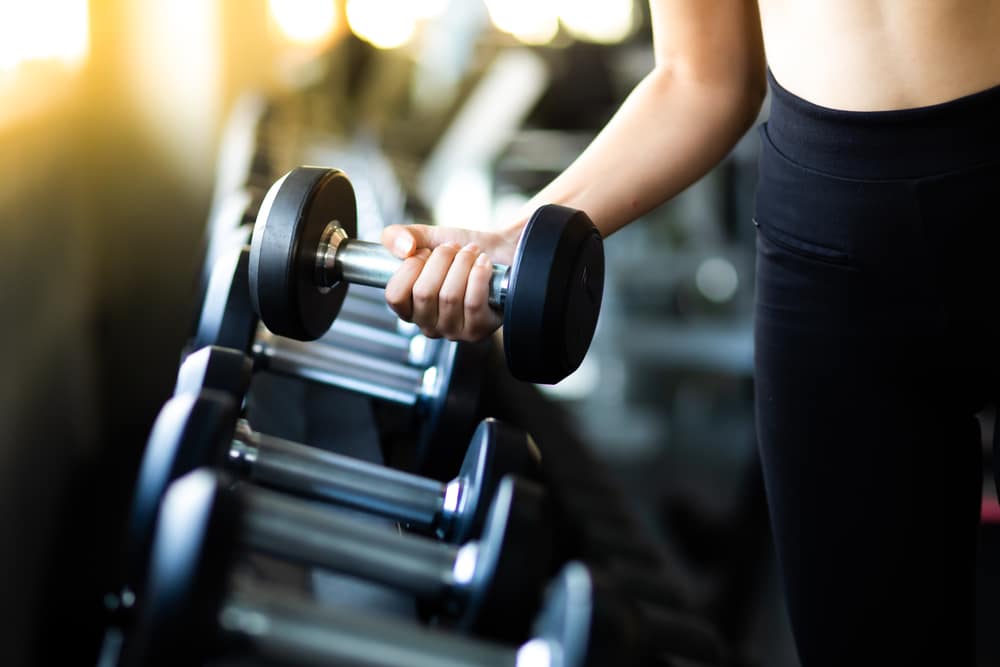
Runners are more prone to injury than many people may think. If you get injured, you may need weeks or even months to recover and return to your normal running routine.
The good news is that there are things you can do to support injury prevention and speed up your recovery process. The best way to efficiently rehabilitate your body post-injury and reduce the overall risk of future injuries is with strength training – specifically weight lifting.
Keep reading to learn what weight lifting for runners can do for you and how to incorporate weight lifting into your routine.
Quick Navigation
What Is Weight Lifting for Runners?
Weight lifting for runners is a form of strength training and cross-training. The point of weight lifting is to increase muscular strength and endurance to boost your performance and minimize the risk of injury.
Some of the top benefits of weight lifting for runners include:
-
- Build muscle
-
- Improve running efficiency
-
- Increase maximum sprint speed
Let’s take a look at the benefits of weight lifting for runners.
Benefits of Weight Lifting for Runners
There is an endless list of benefits of weight lifting, but the benefits for runners are even greater. Some of the benefits of weight lifting for runners may surprise you.
Firstly, lifting weights can help you run faster. Weight lifting encourages coordination and stride efficiency. According to the British Journal of Sports Medicine, strength training enhances running economy by 2-8%, theoretically improving endurance and running performance by allowing the runner to run at a lower oxygen or energy cost during training.
What’s more, weight lifting for runners also helps prevent injury. Lifting weights gives you stronger muscles, connective tissues, and bones, which are all critical for running. When you strengthen these parts of your body, your risk of injury decreases drastically.
Beyond the direct benefits to your daily runs, weight lifting is good for your overall health, including weight control and blood sugar. When your health is in good shape, you can run for a longer period of time and well into the future.
Now that you know why weight lifting for runners is essential, let’s look at three strength training exercises you can incorporate into your routine.

3 Weight Training Exercises for Runners
To get you started, here are three weight training exercises to put into your routine.
Squats
Squats are one of the best compound exercises you can do. Compound exercises are exercises that work multiple muscle groups at the same time. For squats, this means targeting quads, calves, and glutes. These are all essential muscle groups for running.
To do a weighted squat, you’ll need a weighted barbell.
Here’s how to do a proper squat:
-
- Place your feet slightly wider than hip-width, ensuring your toes are turned slightly out.
-
- With your chest up and out, engage your core and shift your weight back into your heels while you push your hip back.
-
- Lower yourself into a squat until your thighs are as parallel to the floor as possible. Make sure that your knees stay aligned over your toes.
-
- While keeping your chest out and core tight, push through your heels to stand back up to your starting position. Squeeze your glutes at the top.
-
- Do 3 sets with 10 to 12 reps per set.
Deadlifts
Deadlifts are another common compound exercise and one of the best compound exercises you can do. This is because they target almost every major muscle in your body and engage your core.
To do a deadlift, you’ll need a weighted barbell.
Here’s how to do a proper deadlift workout:
-
- Stand with the barbell on the floor in front of you with your toes under the bar. Keep feet hip-width apart.
-
- While keeping your core tight and your spine neutral, drive your hips back and squat down.
-
- Grab the bar by placing your hands slightly wider than where your thighs are.
-
- Keep your knees soft and push through your heels as you lift.
-
- Pull the bar up so your hips and the bar rise simultaneously, keeping the bar close to your body as you lift. Once you’re up, squeeze your glutes.
-
- Slowly lower the bar to the ground while hinging at the hips.
-
- Do 10 to 12 reps and 3 sets.
Bench Press
The bench press targets the muscles in the upper body, primarily the chest. A strong chest contributes to better endurance and performance for your runs.
To do this compound exercise, you need a weighted barbell or dumbbells and a flat bench. A rack also helps but is not necessary.
Here’s how to do a proper bench press workout:
-
- Lie down on the flat bench.
-
- Grip the barbell with your hands slightly wider than your shoulder. Make sure that the bar is directly above your shoulders. Press your feet firmly into the ground, keeping your core engaged and your hips on the bench.
-
- Slowly lift the dumbbells or bar off the rack. Lower the bar to your chest and bend your elbows about 45 degrees from the body.
-
- Lower yourself until your elbows are just below the bench. Push the bar back up to return to starting position, pressing your feet into the floor as you do.
-
- Do 6 to 10 reps for 3 sets.

Other Weight Lifting For Runners Tips
Below are some additional tips for weight lifting for runners.
-
- While there are benefits to lifting both light and heavy weights, runners should focus on heavy-weight lifting. The endurance that results from light lifting is similar to that in running, making it redundant. Your focus for weight lifting should be to build muscle by using a heavier weight.
-
- One of the biggest myths about weight training is that it causes your body to bulk up. This may sound scary to some runners, who prefer a lean build for ultimate performance, but this myth is not true. As long as you keep running, weight training will make you stronger without bulking you up with muscle mass.
-
- If you want to start lifting weights for the first time, beginning during the off-season is best to give your body time to get used to the new strength exercises.
Wrap-Up: Weight Lifting for Runners to Improve Performance
While weight lifting may not be your choice of physical activity, it can work wonders for your running performance. Weight lifting for runners improves your strength, which as a result, increases your endurance and decreases your chance of injury.
Start by lifting weights once a week and slowly increase the number of times a week you lift. Stay consistent, and you’re sure to start seeing progress in your running performance in no time.

